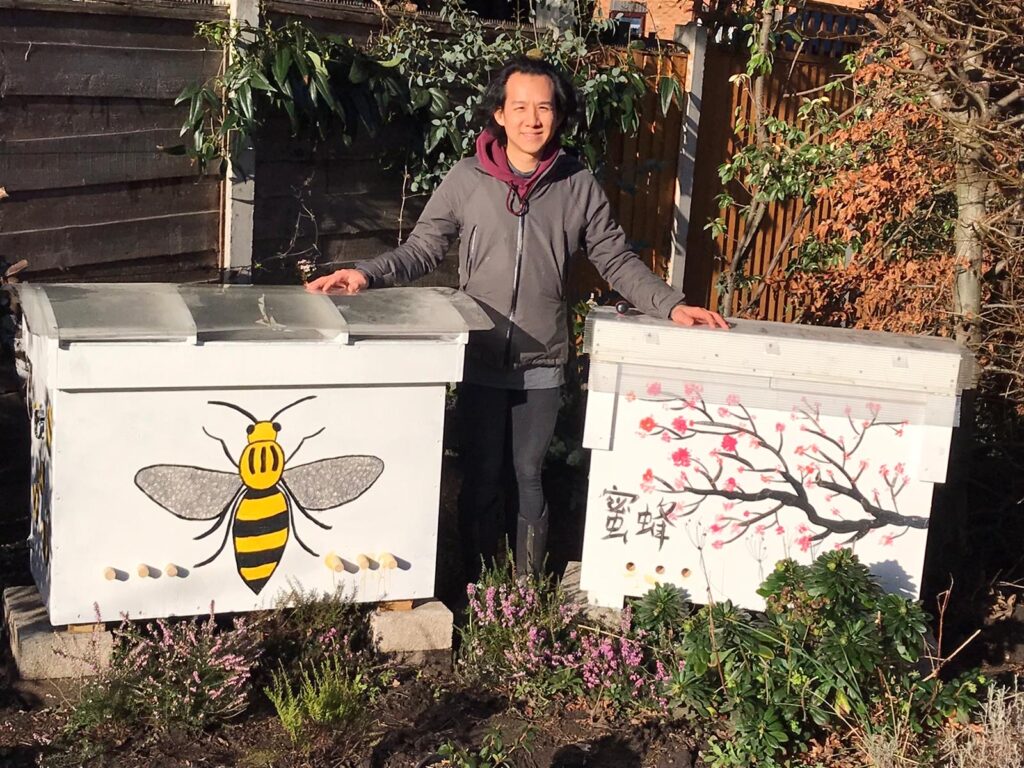
The Manchester hive (pictured left) is our very first beehive, handbuilt by me and lovingly painted by my wife and daughter with the Manchester bee. It is a double-walled, wool-insulated, horizontal hive using Einraumbeute frames, built according to plans by David Heaf, John Haverson and Matt Somerville. The inner walls are rough-sawn, untreated, 100x20mm timber. The frame is made with the same timber. Raw sheeps wool was used as insulation and the outer wall is 18mm marine plywood. It weighs far too much, but should hopefully last a lifetime. The roof was fashioned from marine plywood, scrap polycarbonate and scrap backerboard as a mouseboard. This sits on top of Warre style quilts filled with straw. Instead of hessian as a top cloth, we used a propolis screen which was available from Germany.
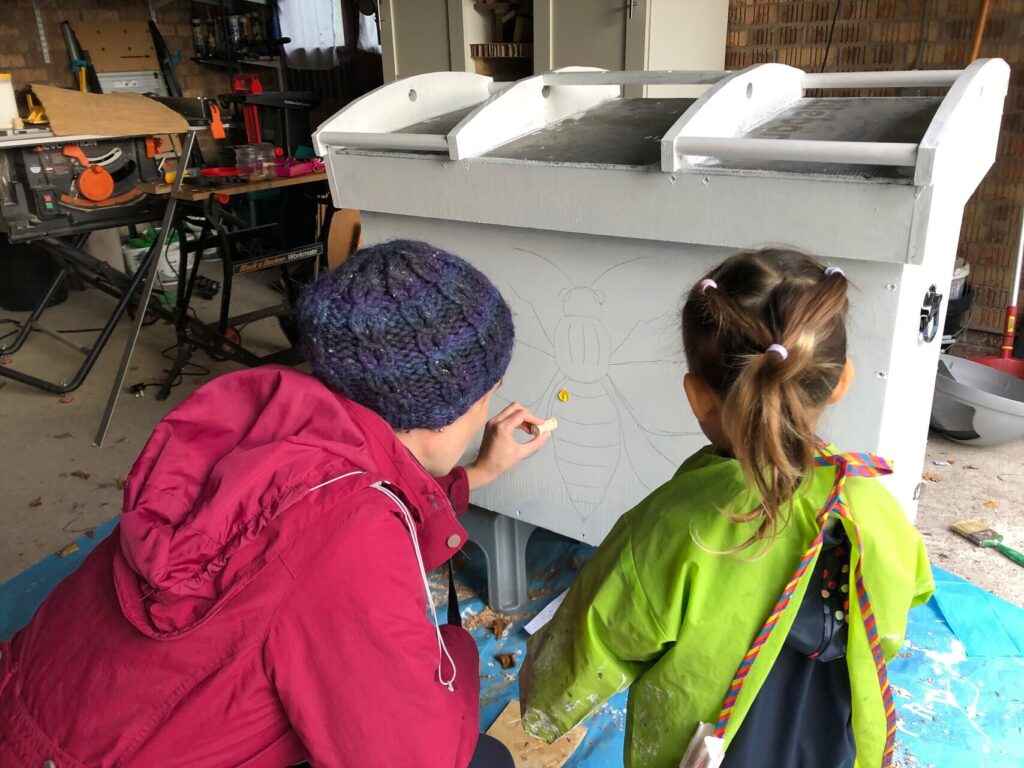
2021
01 July 2021
I got a call from David Heaf the evening before that he had caught an additional swarm. Since it was getting late in the season, and we had not obtained our own swarm, I drove across to Gwynedd to collect it. The weather was warm and sunny. The swarm weighed approximately 1.4kg. After driving it back to Manchester, the swarm trap was placed on top of the Manchester hive and the entrance was opened to allow orientation flights. That evening, after sundown, we shook the swarm into the open Manchester hive and placed a queen excluder on the entrance.
02 July 2021
The swarm attempted to abscond into a swarm trap we placed on our house. This trap was about 10m from and facing the Manchester hive. However, after spending several minutes there, they flew back onto the Manchester hive, congregating on the surface of the hive.
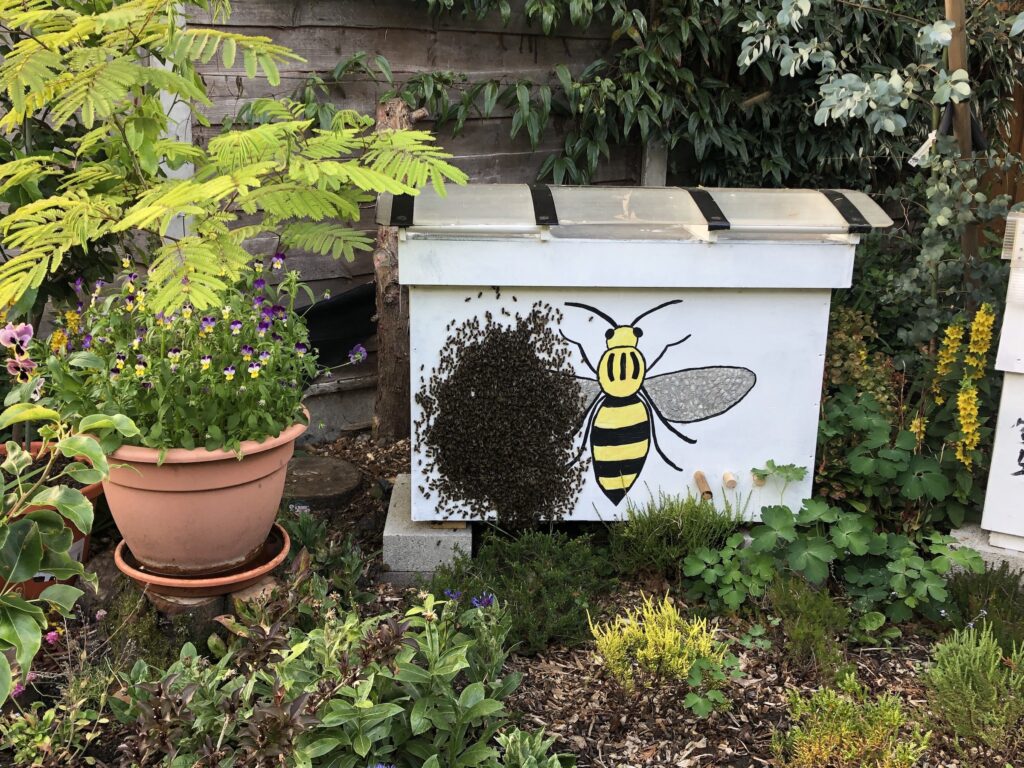
04 July 2021
The bees remained on the outside of the hive for two days, although the number outside decreased. I called David who suggested placing the old swarm trap upside down to see if the bees would run into it. They did, and I managed to get to the extrance and noticed that the queen was dead and stuck to the queen excluder. The colony had tried to abscond and in the process of the stampede across the disc, the queen had gotten stuck and died. This explained why they flew back to the Manchester hive after absconding to our swarm trap.
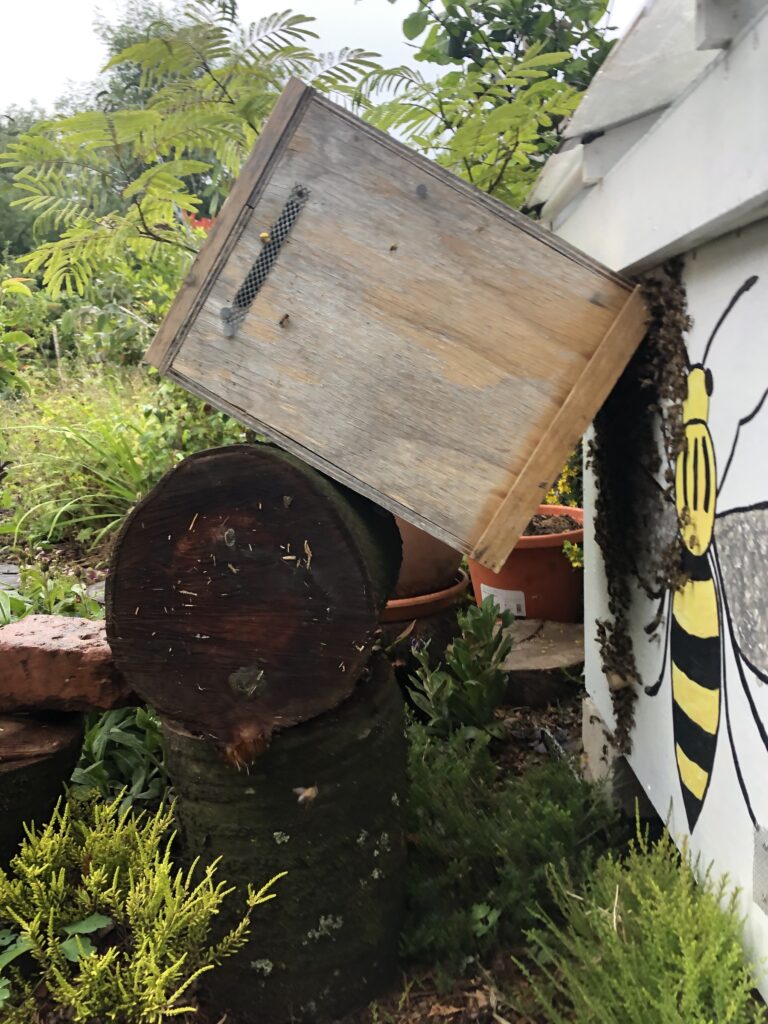
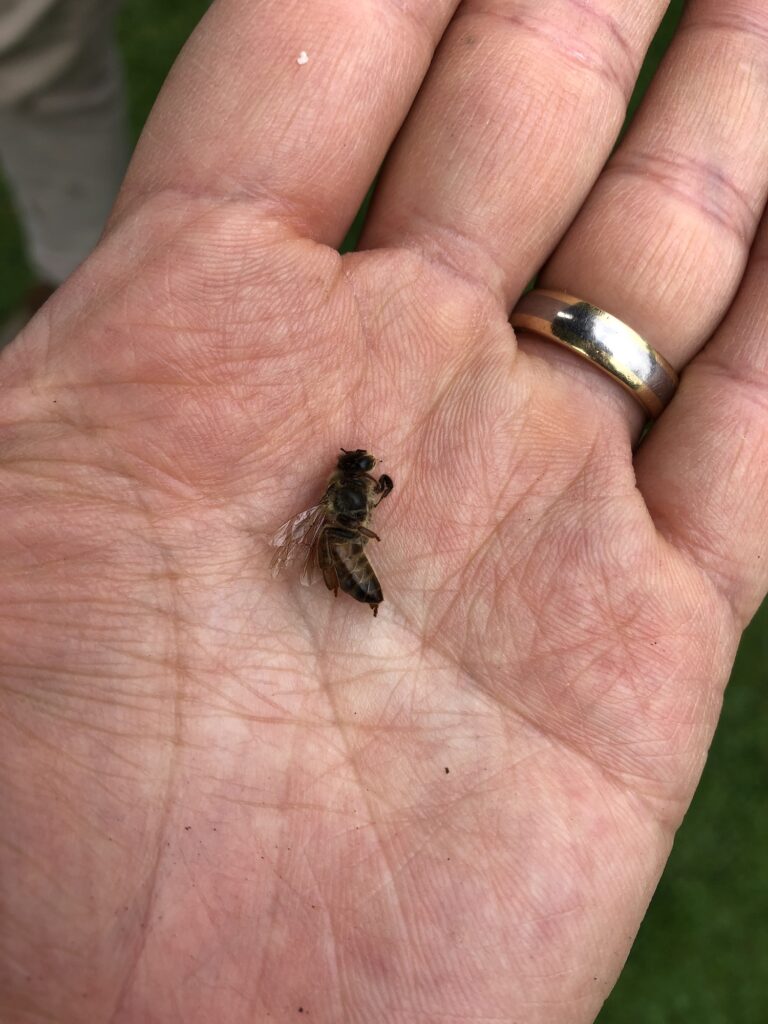
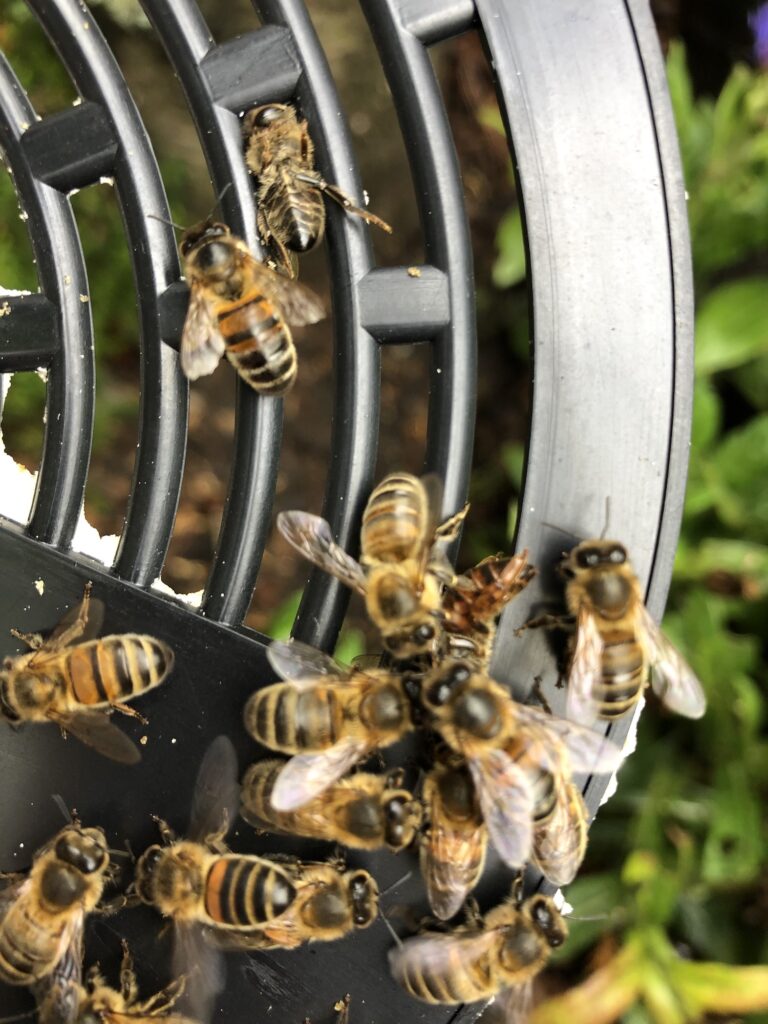
That evening, I dumped the swarm back into the Manchester hive and removed the both the old swarm trap, and the one on the house. The bees stayed in the Manchester hive. We hoped that there was a second queen within the colony, but were prepared to re-queen. Single feed with sugar syrup was given.
09 July 2021
A local beekeeper inspected the hive with us. Several frames contained comb, but the bees tended to build around the wooden support sticks rather than through it. Wires would have been better. There was no brood or eggs. The bees behaved like a queenless colony. We ordered an Apis mellifera mellifera queen off the internet (Becky’s bees).
15 July 2021
The mail-ordered queen was introduced to the Manchester hive. Queen cage was suspended with wires in between two frames. A quick check a couple of days later confirmed that the queen was in the hive. The cage was removed.
01 Aug 2021
Fair weather. Inspection to check on laying-status of newly introduced queen. She was laying and eggs were seen. There were 7 partially drawn frames. I reattached two pieces of dropped cross-comb from the last inspection. Frames were re-ordered alternating with drawn and empty frame to encourage straight comb-building.
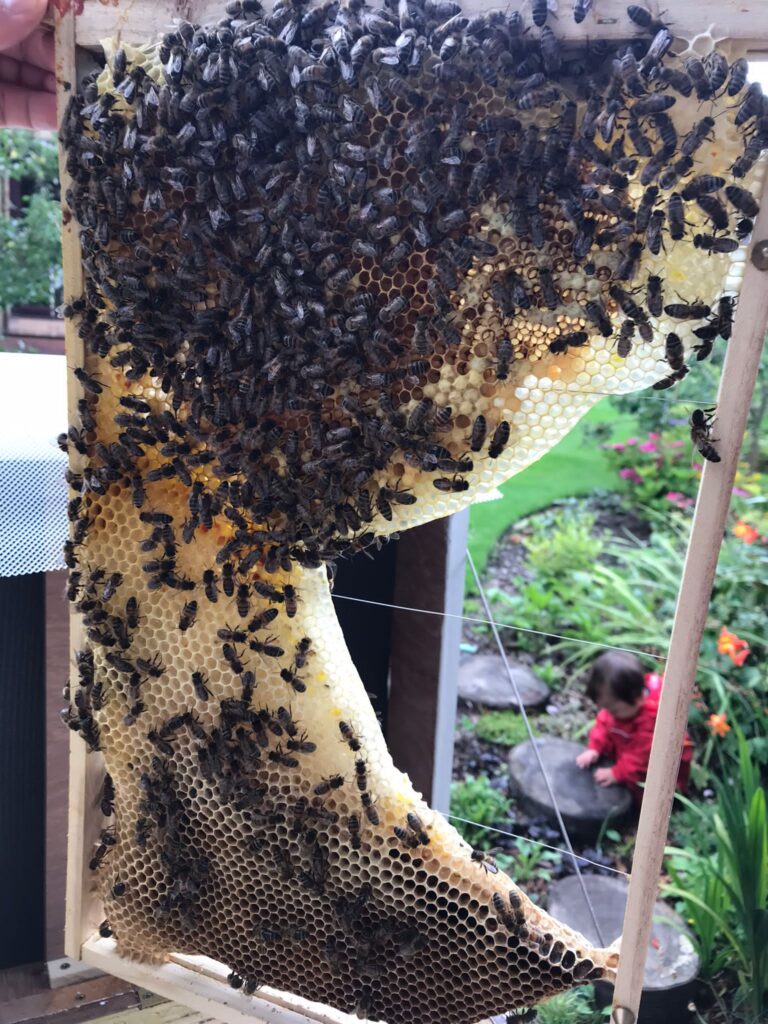
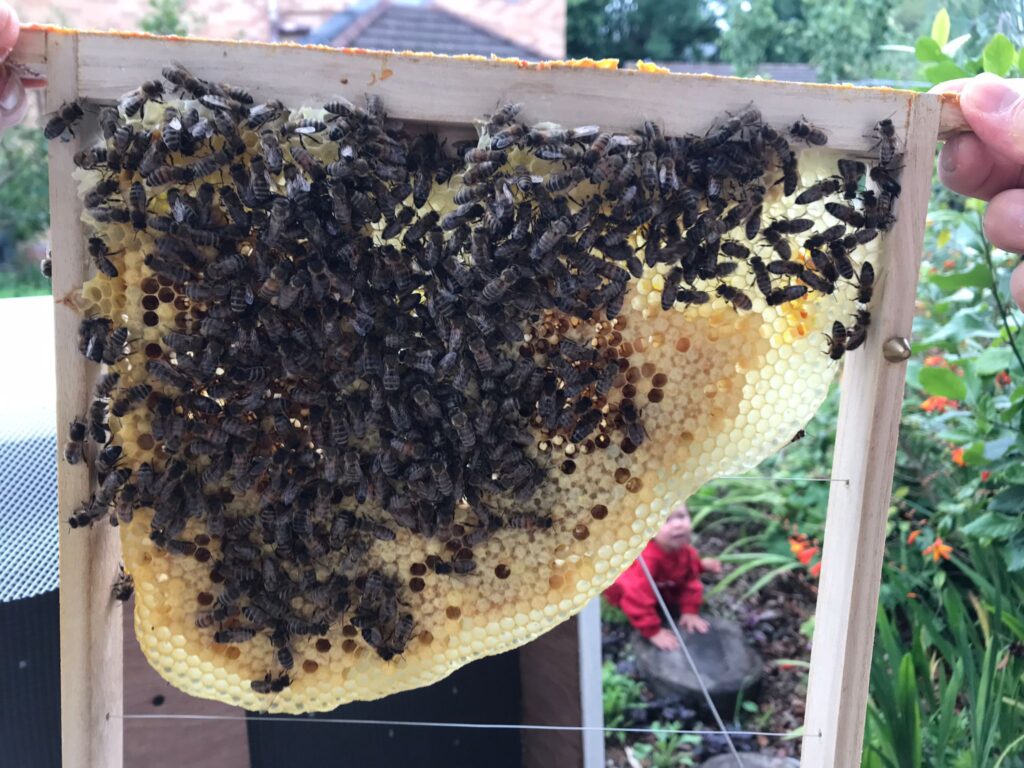
21 Aug 2021
According to the German ERB users, 10 frames were required to over-winter. Therefore, we fed the bees with a 1:1 sugar syrup, placed in a bucket in the void of the hive behind the follower board, with pieces of wood floating to prevent bees from drowning. 3 frames with small strips of foundation were added. Several weeks later, the last couple of frames continued to be empty so these were removed, leaving 8 frames to overwinter.
2022
03 Mar 2022
Over the past fortnight, bees were seen flying occassionally. They were out en masse today. The temperature was 10C with sunny spells. We performed an inspection. There remained 8 frames. Most were between two-thirds to fully drawn. The first frame was half-full of capped honey. There was brood seen in a tight central cluster on three frames. The last 3 frames contained pollen and honey in varying amounts. The final frame was fattened and almost full of capped honey. There were two small areas of comb built towards the walls of the hive from the 1st frame. There were also small areas of cross comb in the middle of some frames.
We inserted 1 empty frame at the front/entrance. This strategy is from the ERB and Layens Facebook groups, and allows for eventual brood comb cycling. We inserted 2 empty frames towards the back, alternating them with built comb. This follows Les Crowder’s Top Bar hive management strategy. We considered harvesting the last, fattened frame of capped honey, according to Leo Sharashkin’s/Fedor Lazutin’s recommendations, but did not do so at this point of time since the weather was set to get colder in the following week.
Over the next week, plenty of activity was seen at the entrance during sunny days. Temperatures ranged between -1 to 10C.
18 Mar 2022
We took a peek into the Manchester hive to determine if further expansion was necessary. The empty frame at position 1 had some comb drawn of roughy 7cm diameter. However, there was a section of cross comb further down between frame 2 and the wall past the empty frame 1. We broke this off. We then decided to replace frame 1 with another frame with a 5cm strip of foundation to encourage straight comb and discourage cross-comb. We shifted the partially drawn frame to the far end of the hive, replacing a completely empty frame, just before the fattened comb. 11 frames in all.
The weather has been very good, with highs of 20C and mostly sunny. Nearby forage: Prunus genus including multiple damson trees by the brook, our cerasifera and incisa, hellabores, crocuses, Ribes, Clematis armandii. Asian pear and conference pear were about to flower.
In two weeks we will have another peek. If cross-comb is encountered again, we will remove frame 1 and replace it with one of the drawn frames from the far end of the hive.
02 April 2022
While the weather was sunny, the temperature was still around 10-12C. Over the previous fortnight, there was plenty of activity and vigorous foraging from the bees. We did an inspection with the primary aim of determining if there was persistent cross-comb.
The bees were calm. There were 11 frames to begin with. Frame 1 was well built with almost no cross-comb bar a few spots where the bees had built it towards the narrow wall of the hive. Comb was drawn two-thirds way down the frame and contained uncapped honey.
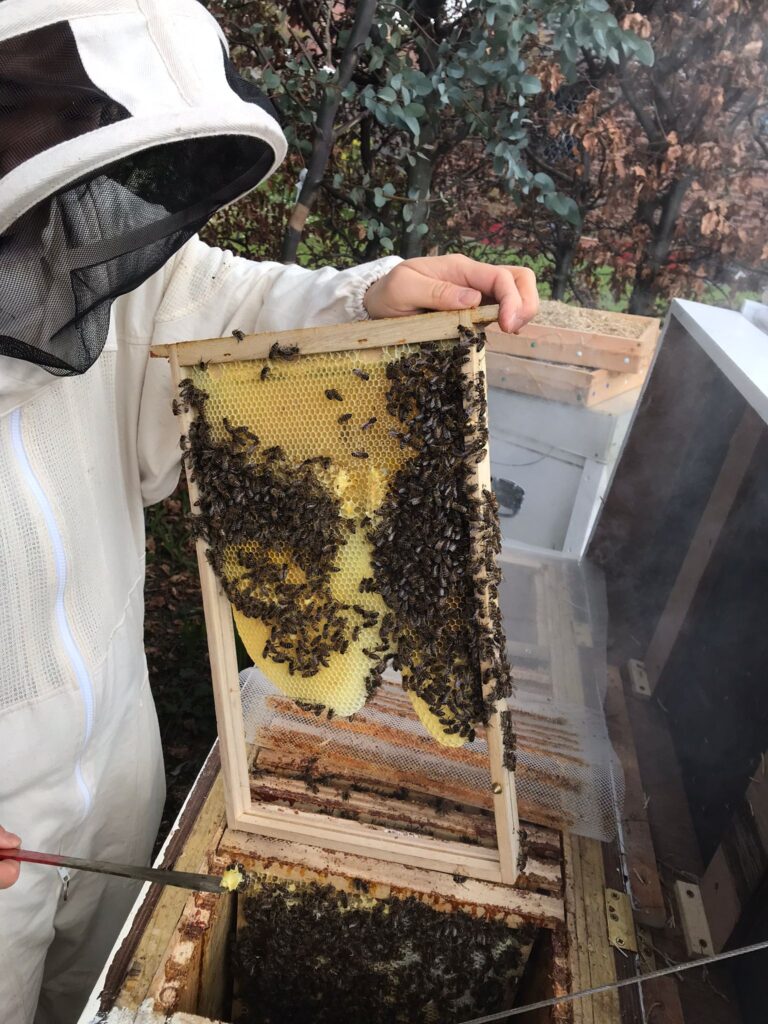
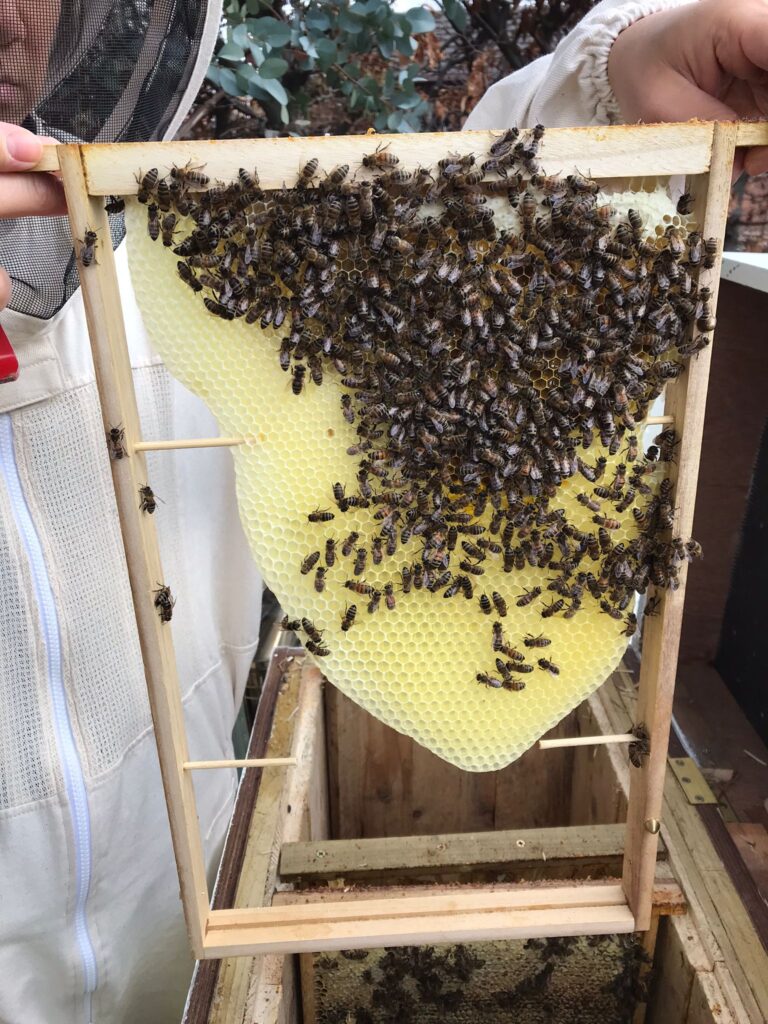
The next few frames contained plenty of brood in a good cluster. Some combs were built almost to the bottom of the frame. Several frames up to Frame 7 contained capped drone cells. There was a single queen cup on Frame 4.
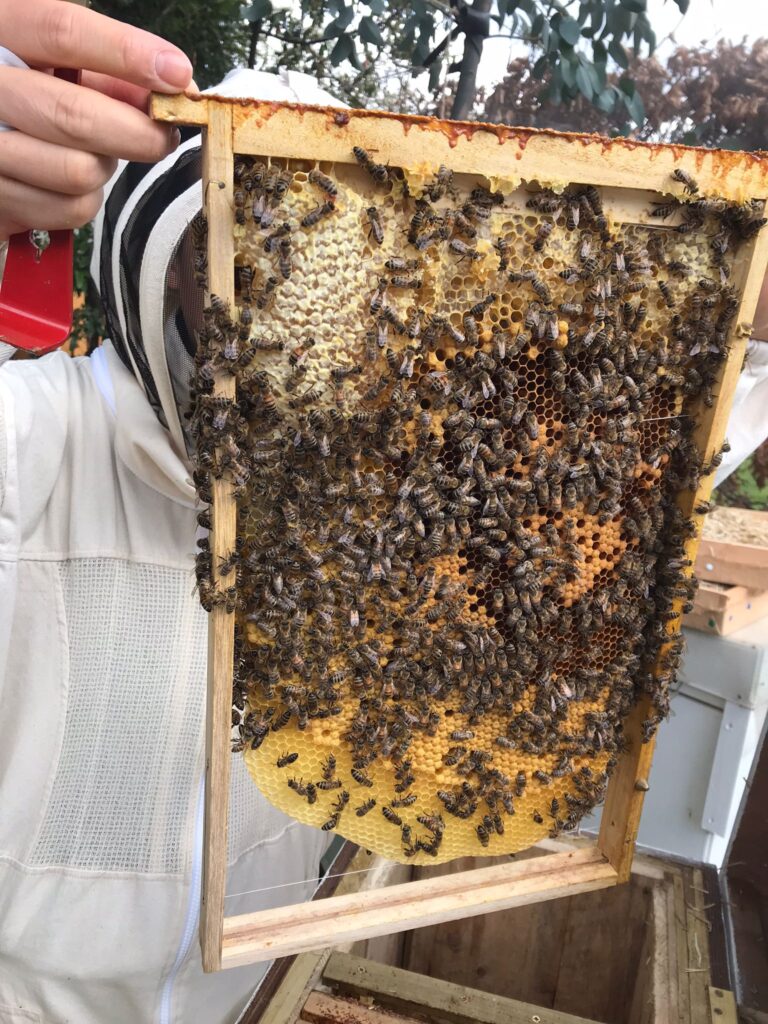
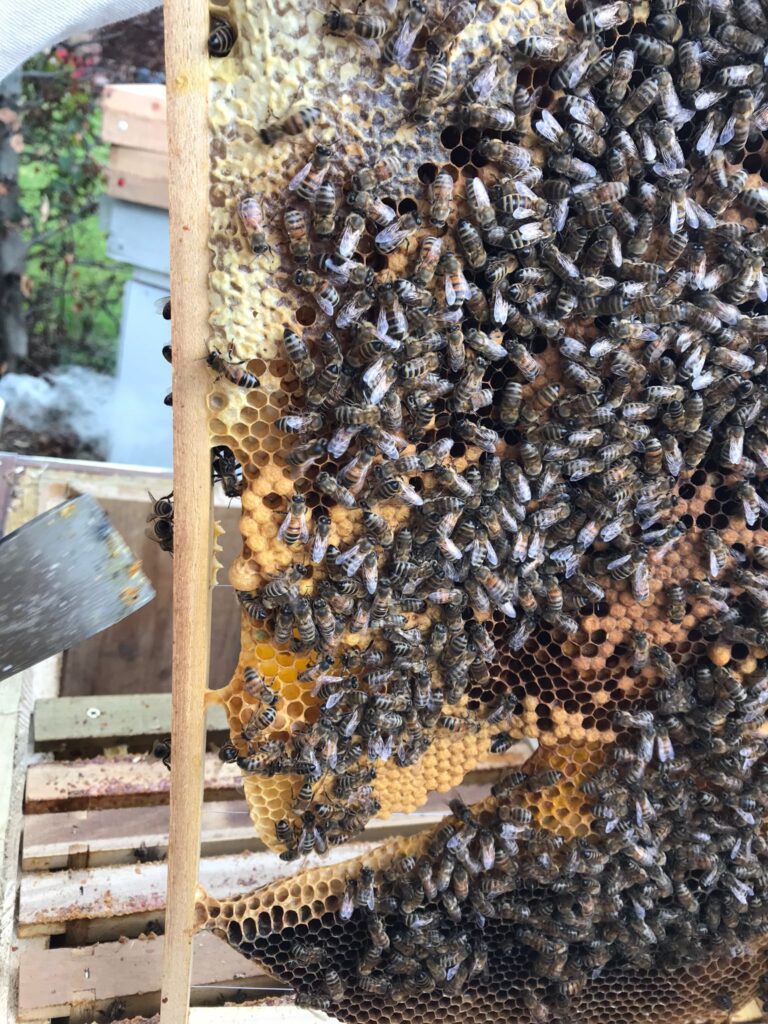
We did not see the queen, although looking back at the pictures, she was right in the middle of one of the frames! Two empty frames were added towards the back of the hive between Frame 10/11 and Frame 9/10.
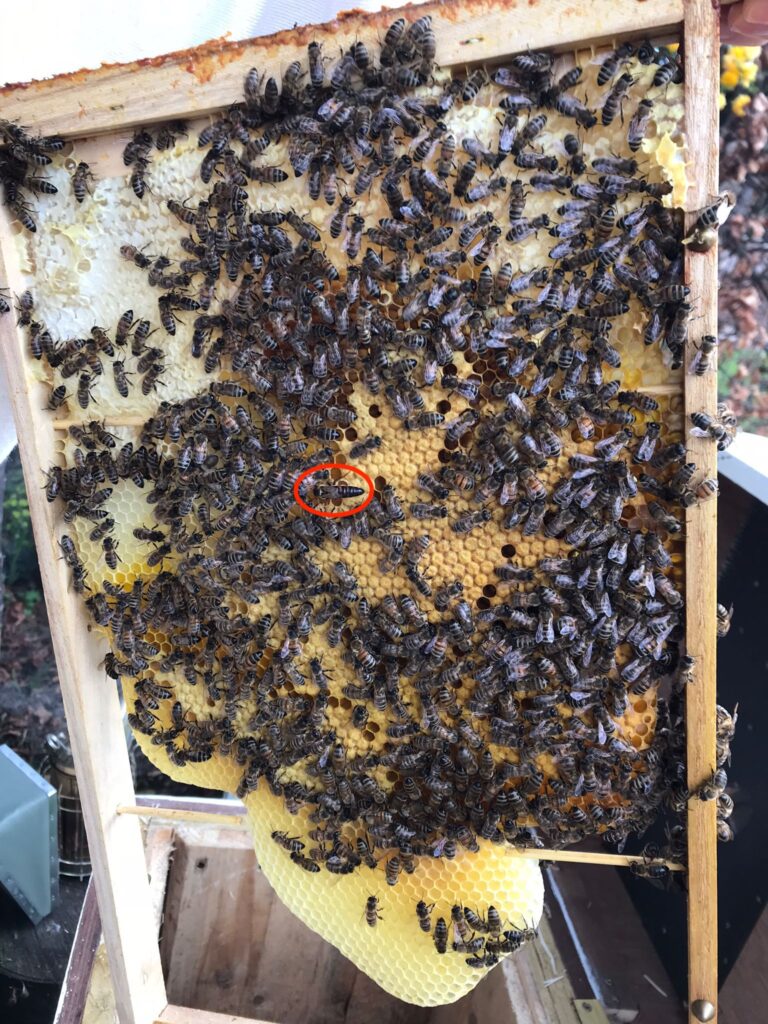
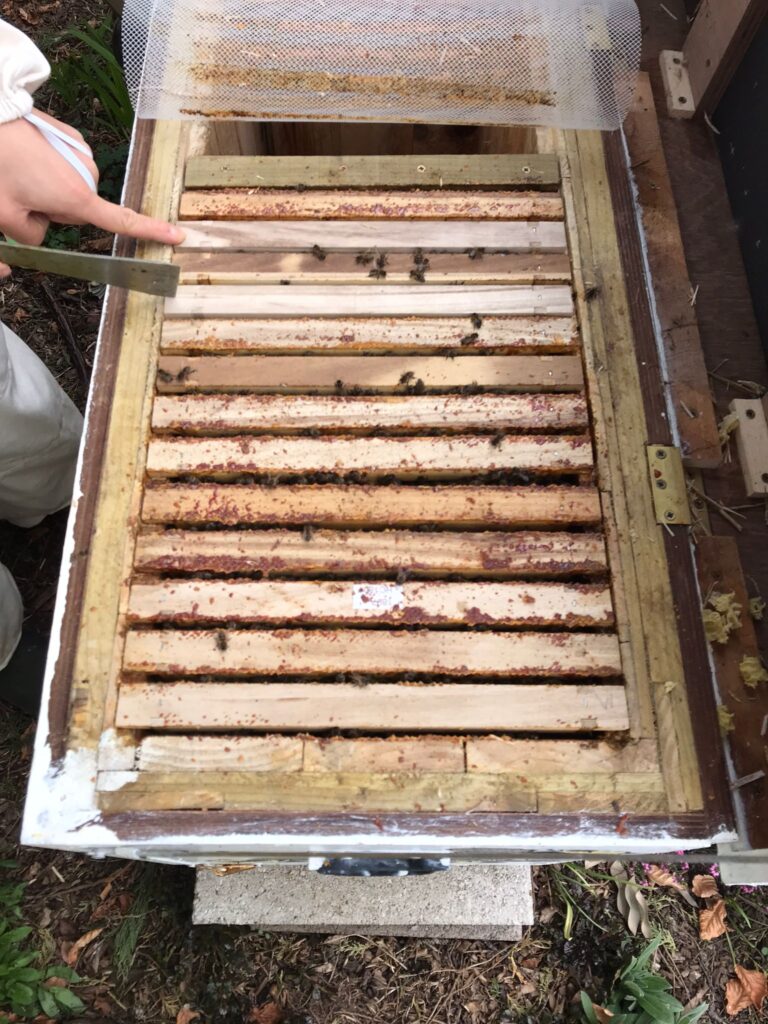
06 April 2022
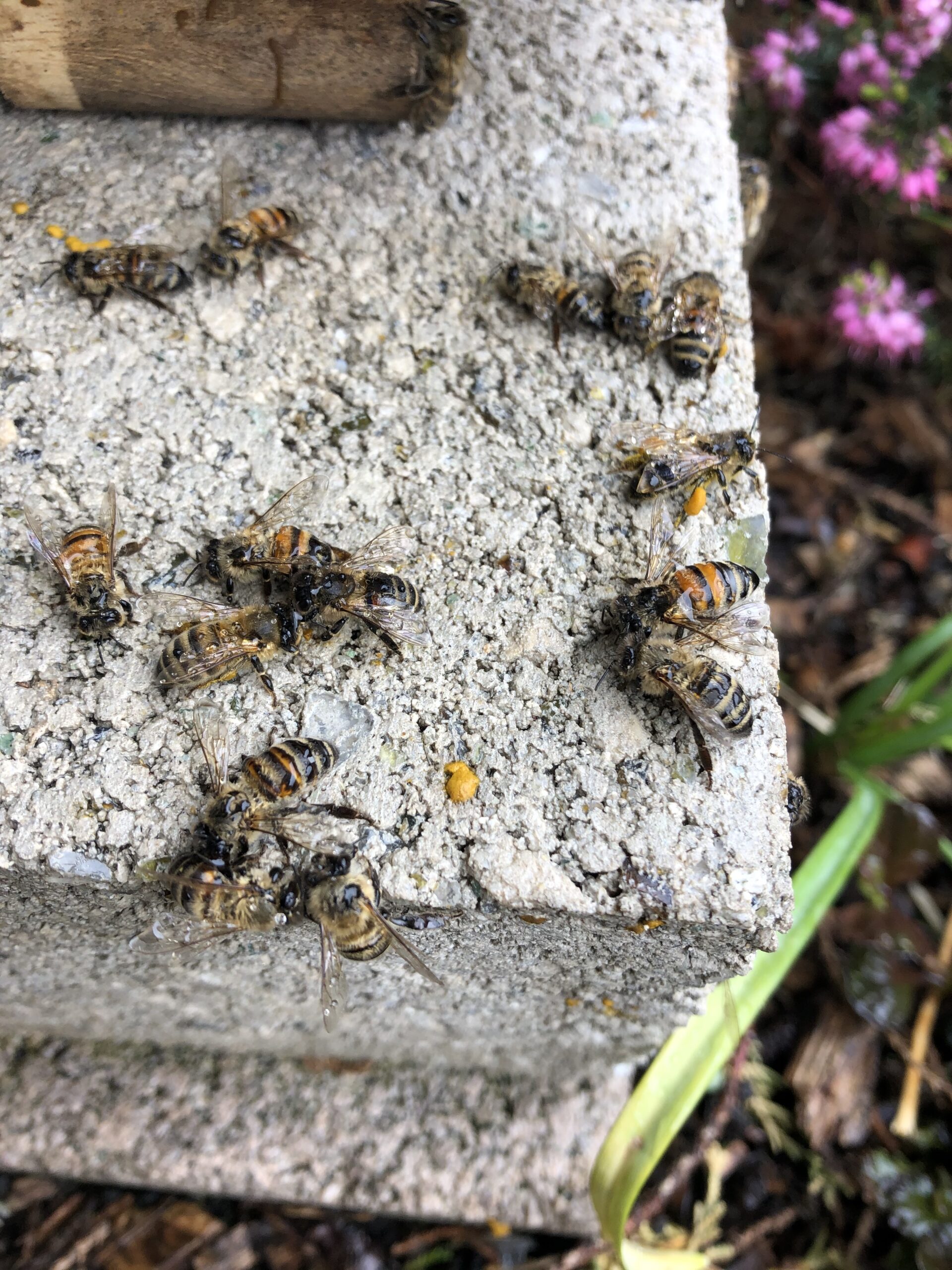
Encountering these seeming mass casualities near the entrance of the hive, I sought some help from the treatment-free beekeeping Facebook group. The responses were a lesson in observation, much like how I learnt to pick up clinical signs throughout medical school! I felt like a student again and relished the opportunity to continue learning. Here were some points:
A cold snap had set in the evening before. The bees, motionless, looked dead, but later in the day, several of them began moving. It was likely that the temperatures induced torpor. The filled pollen baskets suggested either bees that were either not allowed to enter the hive, or too exhausted to make it to the entrance. I failed to notice the various ages of bees, characterised by the hairiness of the thorax of the younger bees compared to the older ones. It was also brought to my attention that one of the bees had a varroa mite on its back. The significance of this is not known. From David Heaf’s work previously, I knew that mite load was likely to be average, but that the colony possessed effective hygeinic behaviour. Therefore, I ignored this finding. The presence of formed faeces was reassuring.
30 April 2022
We inspected both hives with my colleague Neil, also an intensivist and a beekeeper. The weather was good and we saw lots of activity at the swarm trap placed on the house, about 15 metres away from the hive. Lots of bees were ou the face of the hive. We thought that the hive was preparing to swarm. On inspection, there were at least 3-4 frames full of capped drone cells. All frames were drawn, and lots of bees were in the adjacent void. A further few frames were predominantly worker brood. There were many queen cups scattered throughout the frames, but none were elongated into queen cells, and none were open with visible brood. The first frame, which we had added a few week prior, had been built, but the comb was plastered to the wall of the hive. This was a poor decision. We should have put a frame of empty comb from the other end of the hive in order to rotate the brood next rather than an empty frame. Lesson learnt. We concluded that they had run out of space, so 3 empty frames were added alternating with fully drawn comb, towards the end of the hive. In total 16 frames.
11 May 2022
We got a swarm which was transferred to the Freedom hive. Just to be sure the swarm didn’t come from the Manchester hive, I opened the hive partially to see bees festooning in the void and the last empty frame was drawn, so 2 further empty frames were put in to make 18 frames. There were bees everywhere, so we thought it unlikely that the swarm originated from the Manchester hive.
16 May 2022
A further 2 frames were added alternating with drawn frames to make 20 frames in total
11 June 2022
Small inspection to check for progress. Brood nest was not interrupted. Only the peripheral frames were viewed to see if they needed more room. Still plenty of bees, including those in the lateral void past the follower board. These were busy propolising that area. The 2 frames added 3 weeks prior had been drawn, albeit not fully, and only partially filled with honey. After the 2 frames were inserted last, there has been far fewer bees hanging out outside the hive. I was unsure if they had swarmed without my knowing. However, this seemed unlikely considering the number of bees that were still present in the hive and the lateral void. We decided to leave them at 20 frames.
27 June 2022
Quick inspection to determine if more space needed. Frames from 11 June were almost fully drawn and partially filled with honey. Only sufficient space to add 1 more frame before the follower board. This was added. Early harvest may be necessary.
05 July 2022
Previously added frames were partially drawn. Follower board was removed and an additional final frame was added to make 24 frames in all. Hoping not to inspect till autumn harvest.
16 Sep 2022 – Harvest
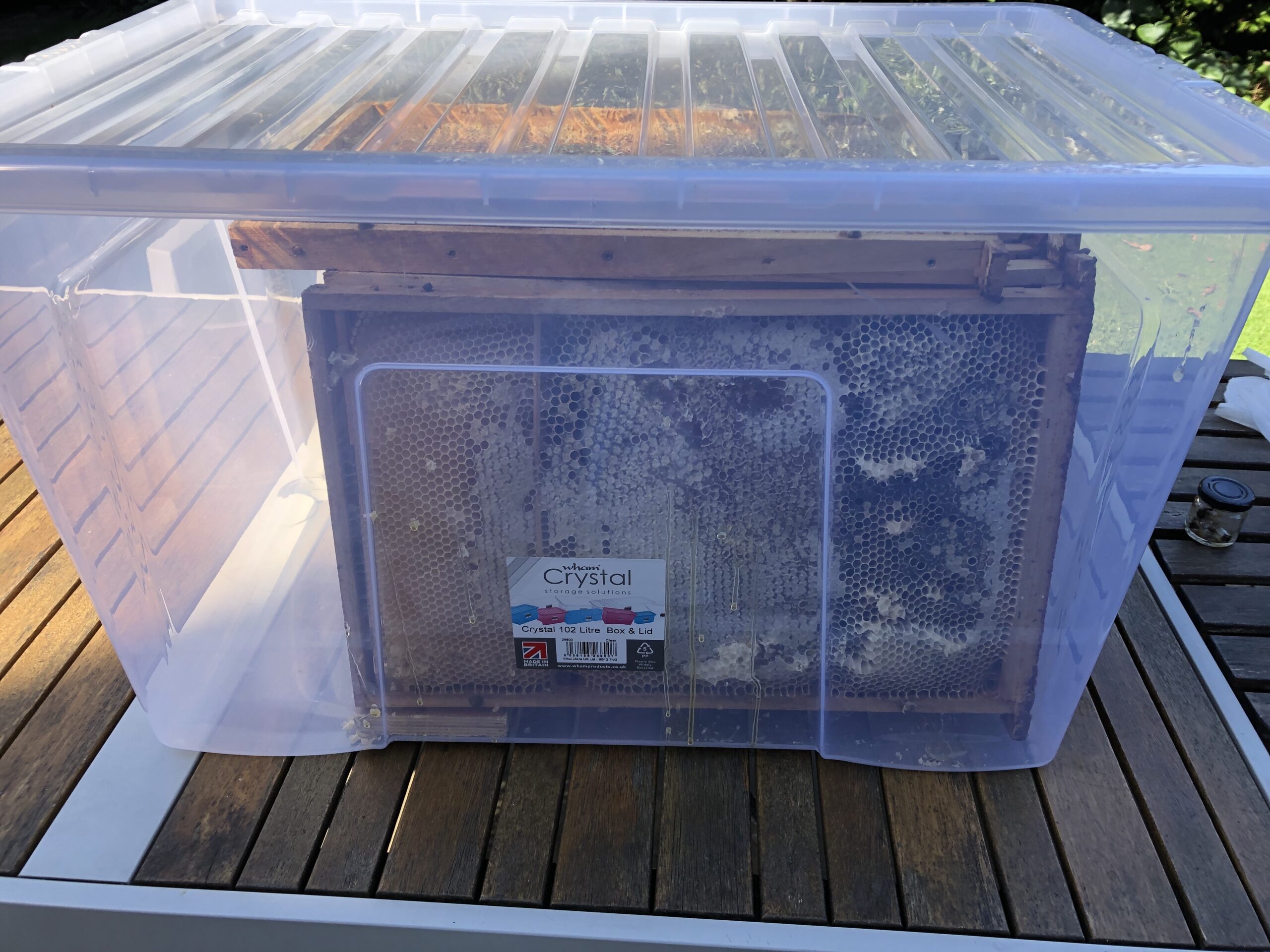
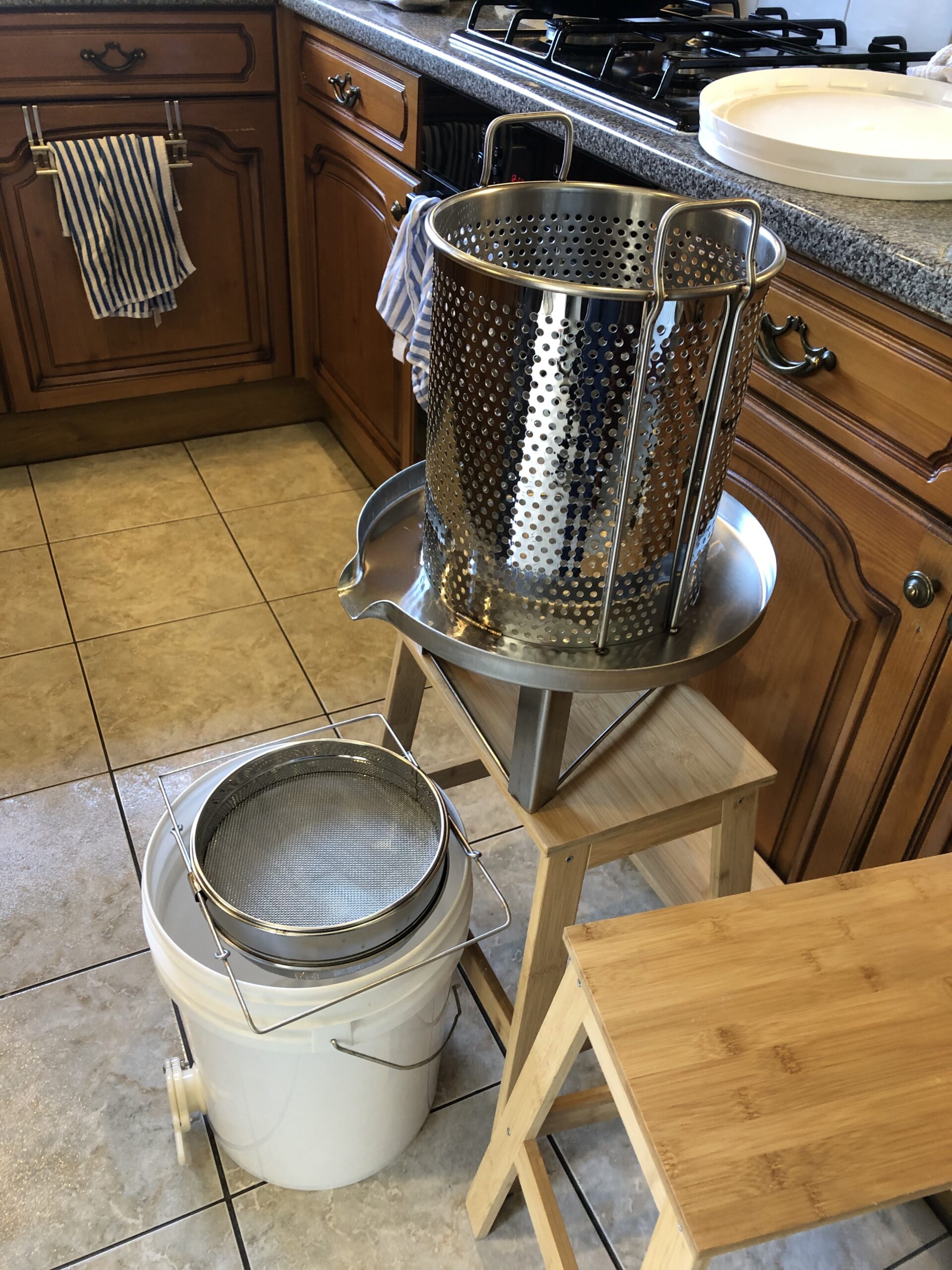
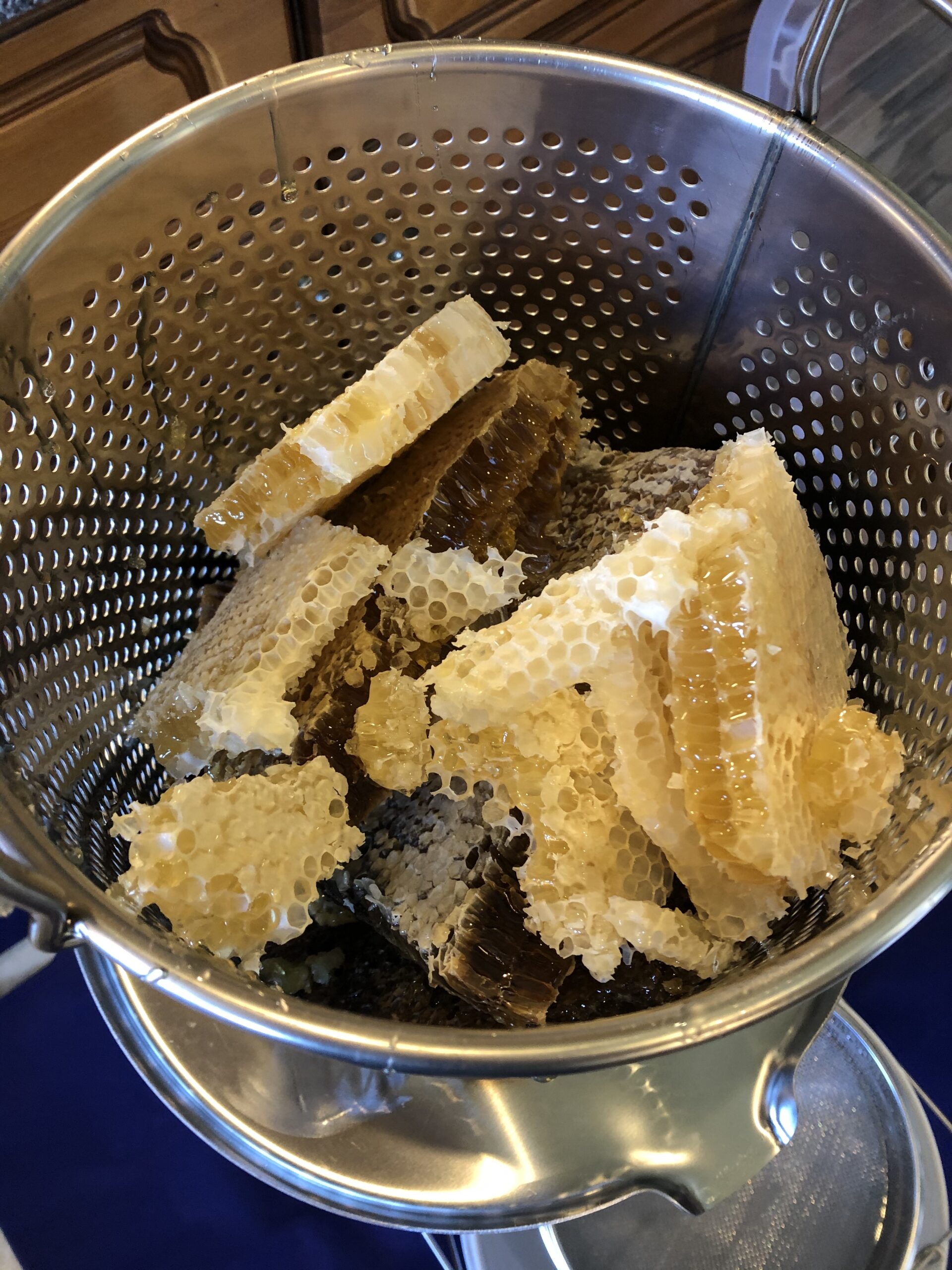
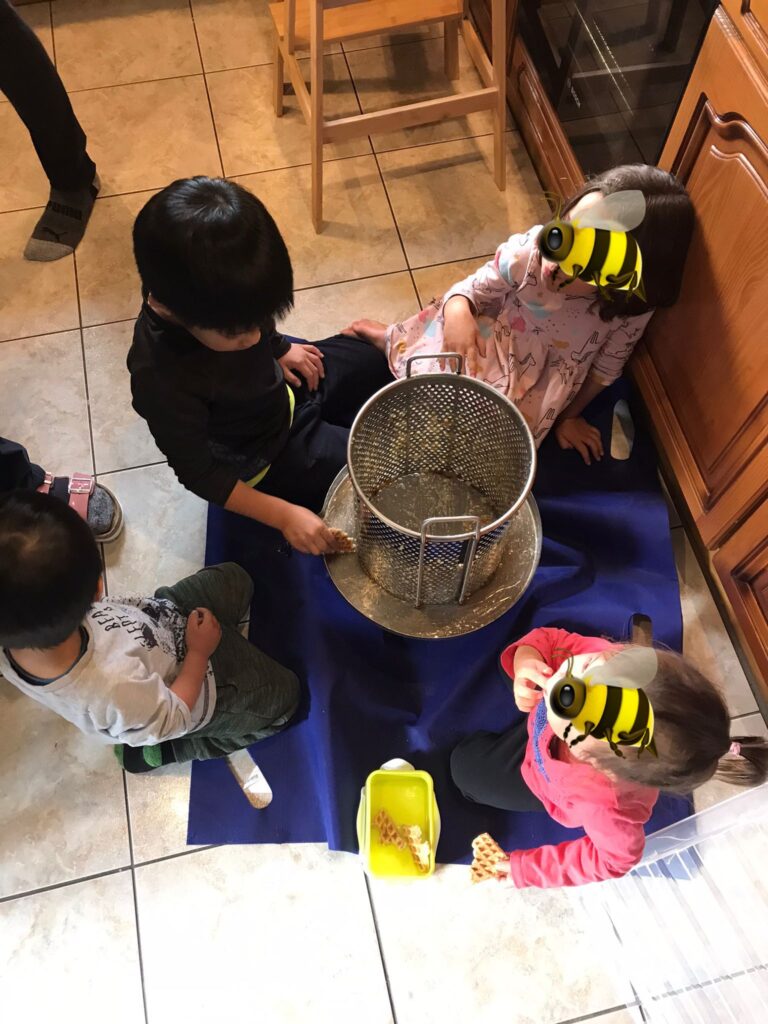
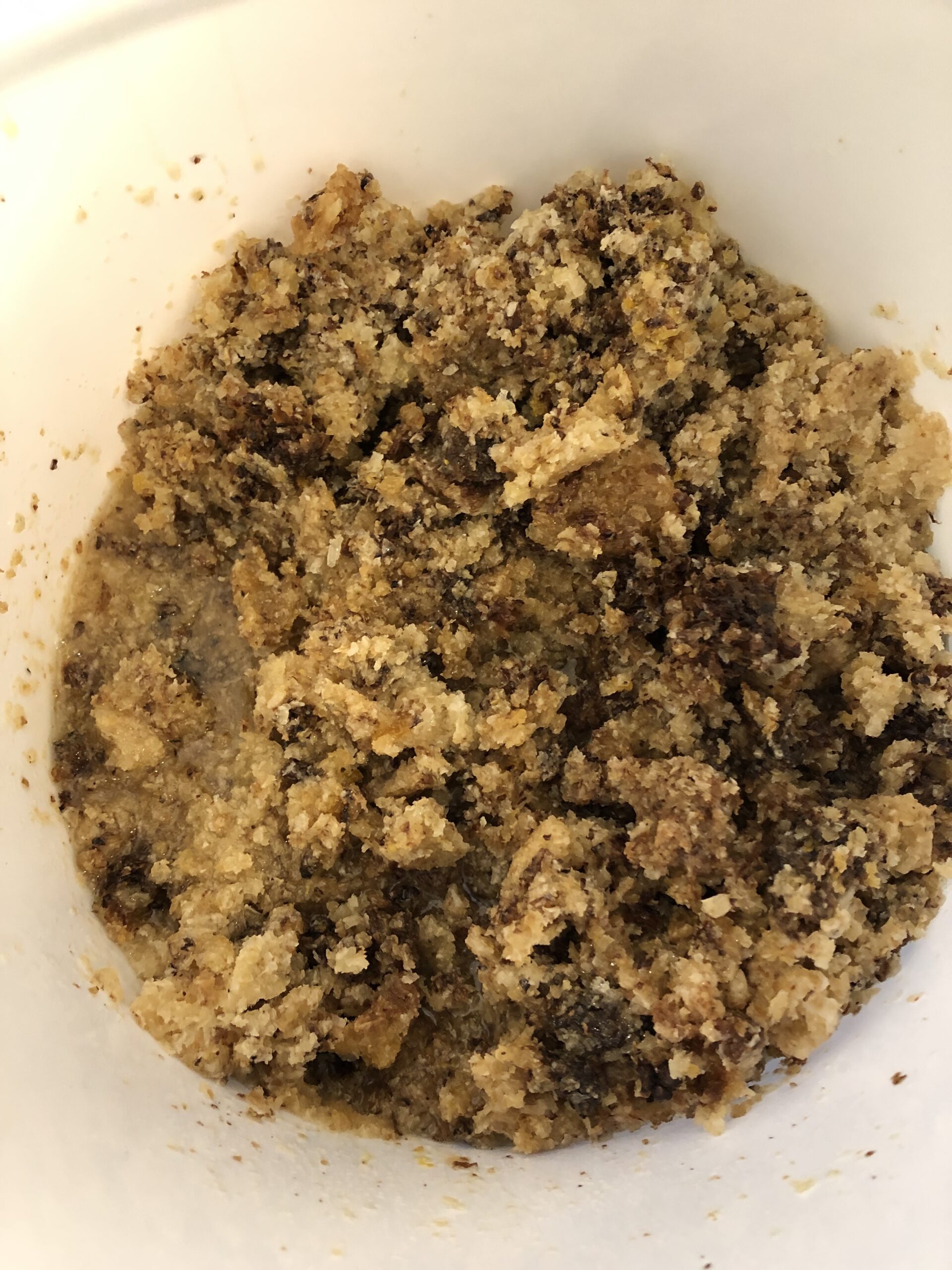
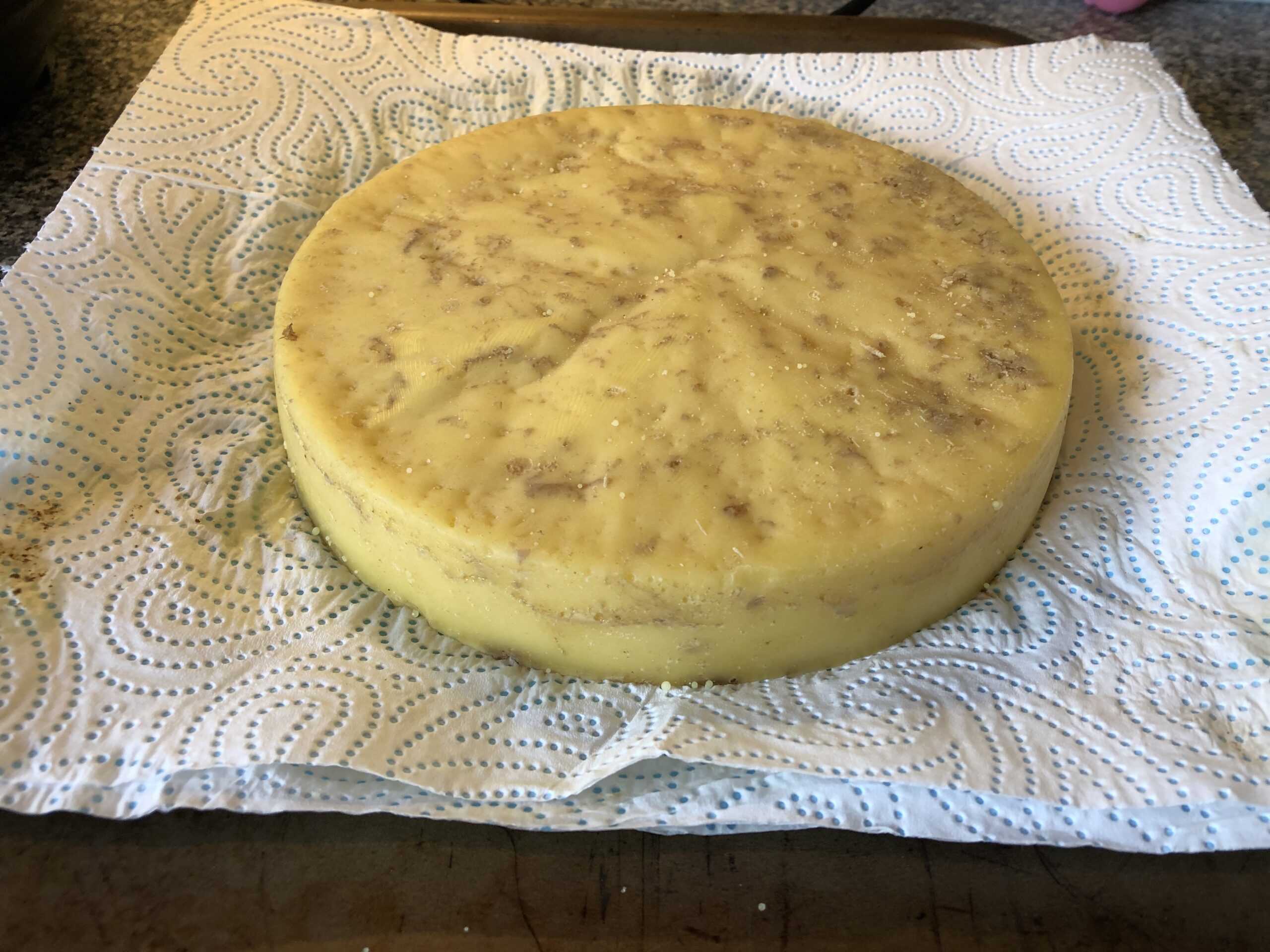
Our very first harvest! We waited till the daytime temperatures were about 12-15C, and inspected in the morning when it was about 10C. This was a decision made to balance several factors. First, lower temperatures mean the colony was likely to cluster, leaving fewer bees to deal with on the honey frames. However, it risks lowering the temperature of the hive and makes the bees expend energy. Second, leaving the harvest later means a higher likelihood of finding capped frames. Third, while Leo Sharashkin’s book suggests harvesting when daytime temperatures drop below 12C, in the mild winters of UK, this would mean a very delayed harvest, well into winter.
We opened the hive, starting from the most distal frame, not knowing what we would find. We left the bees with 24 frames and had not inspected the hive for two months.
The last frame was completely full and capped. This was a thick frame from the start of the colony which I had moved with the follower board. The penultimate frame was added in July and this was only a third drawn with a palm-sized patch of capped honey. The next few frames were almost completely drawn and capped. We took 10 frames, 9 of which were significantly capped.
We had purchased a stainless steel honeypress. The frames were put into a large plastic tub which we had in the garage. They were brought into the house and doors were closed to prevent entry of bees. A knife was used to cut out the combs. They were placed into the honeypress. They needed to be mashed at this stage to release as much honey as possible. I failed to realise how strong honeycombs were and struggled with pressing the combs at first. The honeypress was placed on a stool, on top of a collecting bucket (I bought this 2nd hand). Once mashed, the honey flowed very well. We could crush and strain about 3 full frames at a time. Honey flowed across a two-stage strainer into the collecting bucket.
Pressing was hard work. However, on retrospect this was because we were impatient and wanted to extract as soon as possible. A better way we learnt on the second harvest was to mash the comb, press it slightly, and leave it to flow out. We could then twist the handle to apply more pressure each hour.
For this harvest, we extracted 13kg of honey. This makes between 1-2kg of honey per full frame (we were actually quite inefficient with this first try and left a fair bit of honey due to not leaving sufficient time for honey to flow out). We left them with 14 frames for winter. We did not inspect into the brood nest. Over the next weeks, mouseguards were fitted and a straw pillow was placed in the void after the follower board.
We rendered the wax in an old rice cooker, which worked very well. It was placed into a mesh bag, into water contained within the inner pot of the rice cooker. The cooker was placed either on “keep warm” or “slow cook” function, which eventually melted the wax. Debris was caught in the mesh bag and removed. Smaller particles sank and dissolved into the water below. A layer of fairly clean wax was left floating. This was removed and re-rendered another time to further clean it. It was then poured through a fine strainer into molds.
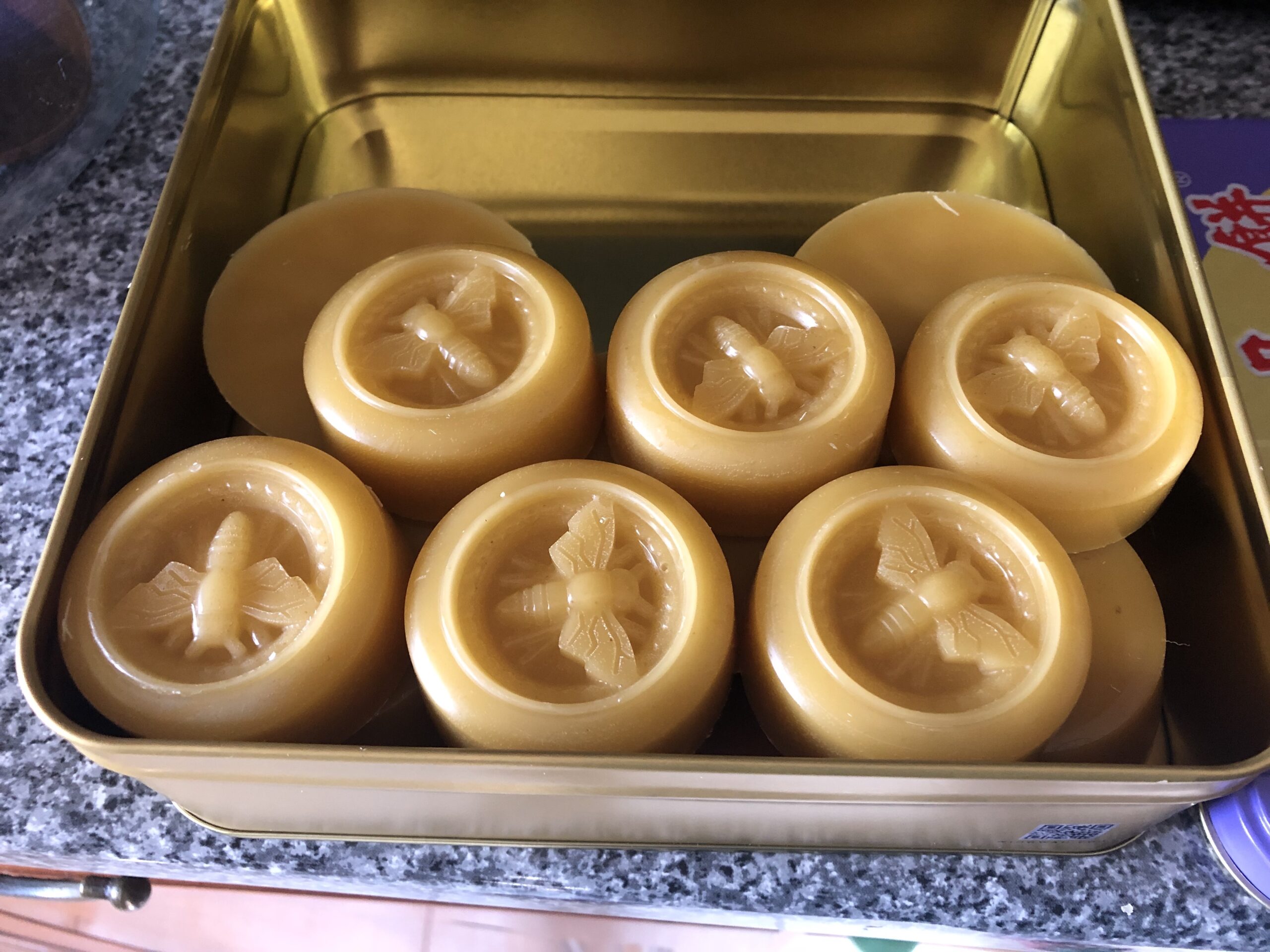
29 Dec 2022
Unfortunately, the second-hand polycarbonate roof had become brittle and showed signs of cracking. I looked at several options for replacement. The ideal one would have been a shepherd’s hut roof. However, there were no supplilers nearby. Alternatively, an aluminium or metal sheet could have been used. Again it was difficult to get this in a sufficiently large size (116 x 60cm). I wanted to try corrugated roof sheets. However, there were concerns that they would not bend to the curve of the roof. Therefore, I went back to polycarbonate. This was purchased as a 70 x 240cm sheet of 10mm double-walled polycarbonate. The leftover would be used to replace the roof of the Hardwood hive too. Ideally, the peaked roof of the Hardwood hive would suit phenolic resin plywood, but since I chose to use polycarbonate for the Manchester hive, using the leftover for the Hardwood hive would reduce waste.
2023
17 Mar 2023
Throughout winter, the Manchester hive was active on good days. Many bees were seen flying for the last few weeks. In mid winter, I stuck an endoscope through the entrace. The floor of the hive was full of dead bees. I was slightly worried, but activity continued so this eased by anxieties.
The weather was amenable to inspection. Temperature was 11C. The far end of the hive was moldy and damp. I am not convinced the straw quilts are beneficial for winter. There were 14 frames in total. Many frames were still full of honey. There was a small area of capped brood on frame three or four. Some honey stores had been used up towards the middle of the hive, but plenty left to spare on both sides. As the weather was still cool, I took the opportunity to release the first comb closest to the entrace, which was previously stuck to the wall. It did not take much effort to release and there was minimal breakage.
I rearranged the hive according to Les Crowder’s principles. Three honey frames were moved from the back of the hive towards the front nearer to the entrance. The brood was moved towards the middle of the hive. Hopefully, this will encourage the honey stores to be used up closer to the entrance and the comb might then be used for brood. I did not look or the queen, nor eggs. The presence of the small area of brood, in addition to the vigorous forage going into the hive were sufficient information for me. No additional frames were added yet. This can wait till the weather warms up slightly.
03 Apr 2023
We did a limited inspection with the intention of adding frames for the season. A single queen cell was seen on one of the frames. However, I did not inspect beyond the last 5-6 frames. There was drone and worker capped brood up to the penultimate frame. 4 frames were added in alternation to make 19 frames in total.
22 Apr 2023
Good activity at the hive entrance over last few weeks. Planned to add more frames. Limited inspection. Follower board removed. All additional frames were at least half drawn. Drone comb all the way to last frame. Very healthy colony, as expected. 4 additional frames added to make 23. Follower board had to be removed. The hive is full for the season. I may need to harvest early.
15 Oct 2023 – Harvest
I essentially left the Manchester hive to its own devices since April. That’s 6 months undisturbed. On this day, we harvested from it. The colony has been strong all season, and indeed, the brood nest extended till frame 15. I therefore only harvested 7 frames. These were at different stages of comb development, but mostly almost full. Most of these 7 frames had capped honey at least in the top half of the frames. There was little uncapped honey. I noted that the bees were foraging ivy nectar and pollen. When crushed and strained, this came out to 13kg of honey. The honey was rich, pungent and very tasty. I did not test for water content based on data from David Heaf suggesting this style of hives usually have capped honey at 13-15% water.
For winter preparation, I filled a hemp coffee sack with about 7 layers of wool sheets. These were obtained from a friend who had them as part of insulation for fresh cat food. This was then fitted into the void. This should provide far more insulation than the straw pillow last winter, and hopefully less condensation in the void. Reduced to single entrance. Probably won’t bother with mouseguards this winter.
2024
11 Apr 2024
First inspection done with friends Mike and Carolyn. Cold winter. Wet spring so far. But generally good activity throughout from the Manchester hive. Surprisingly, there was a fair bit of damp on the lateral void of the hive, including the wool-filled pillow. The bees were irritable, and the floor of the hive was damp and filled with a thick layer of dead bees. Same findings in 2023. Colony itself looked strong, with good brood pattern and already a good number of drones. Queen seen. Frames 3 and 4 full of honey shifted towards end of the hive, but bees became aggressive so frames 1 and 2 which were also honey frames left alone. The hatch was opened and floor rapidly cleaned but this really irritated the bees and many came out from the bottom of the hive to attack me. Closed up quickly. Will need to add frames in a few weeks, but decision made to leave alone for now.
Thinking about it, damp was possibly due to the fact that this hive does not have an insulated floor like the other hives. The walls did not suffer with the same problem as they are insulated. To correct this, there were two options. First, to put external insulation every winter. This would involve securing wool or other insulation outside the floor, below the hive. However, this would be subject to the elements. Second, to put internal insulation and slightly reduce the height of the void. This seemed prefereable to me, but would involve opening the hive. I decided on some foam tiles that my children were no longer using, to 2cm thickness. On top of that would be spare plywood from other projects.
20 Apr 2024
Good weather today, albeit still a little cold with max of 14C and min of 3C. For the past week or so, I had been planning a way to insulate the bottom floor. We had some children’s foam puzzle square tiles which we were going to put away. I cut them to size, with just under 3 tiles making the length of the floor of the hive. I then cut 2 pieces of scrap plywood to size. I needed to have at least 2 pieces to slot each in from the bottom void. With these all prepared beforehand, I opened the void and put 2 layers of tiles (1cm thick each layer), followed by the piece of 9mm plywood. On the far end of the hive, I could then easily reach from the top to secure the entire 3 layers to the bottom floor with screws. However, I struggled to do so towards the front of the hive, as the bees became quite agressive and upset. So I decided to expand the hive and leave. 7 frames were added in alternate fashion toward the end, after moving a couple of frames of drone comb to the back of the hive. Small gaps were filled with slithers of wood to prevent bees from getting to the foam. Hopefully, the bees will propolise the seams and not chew the foam away. Total of 23 frames. Will not inspect until harvest.
13 Jul 2024
The Manchester hive continues to thrive. Limited inspection mainly to remove a brood comb for the Brown hive. Plenty of honey, followed by really good pattern of brood after about 4-5 frames of honey. No further inspection done.

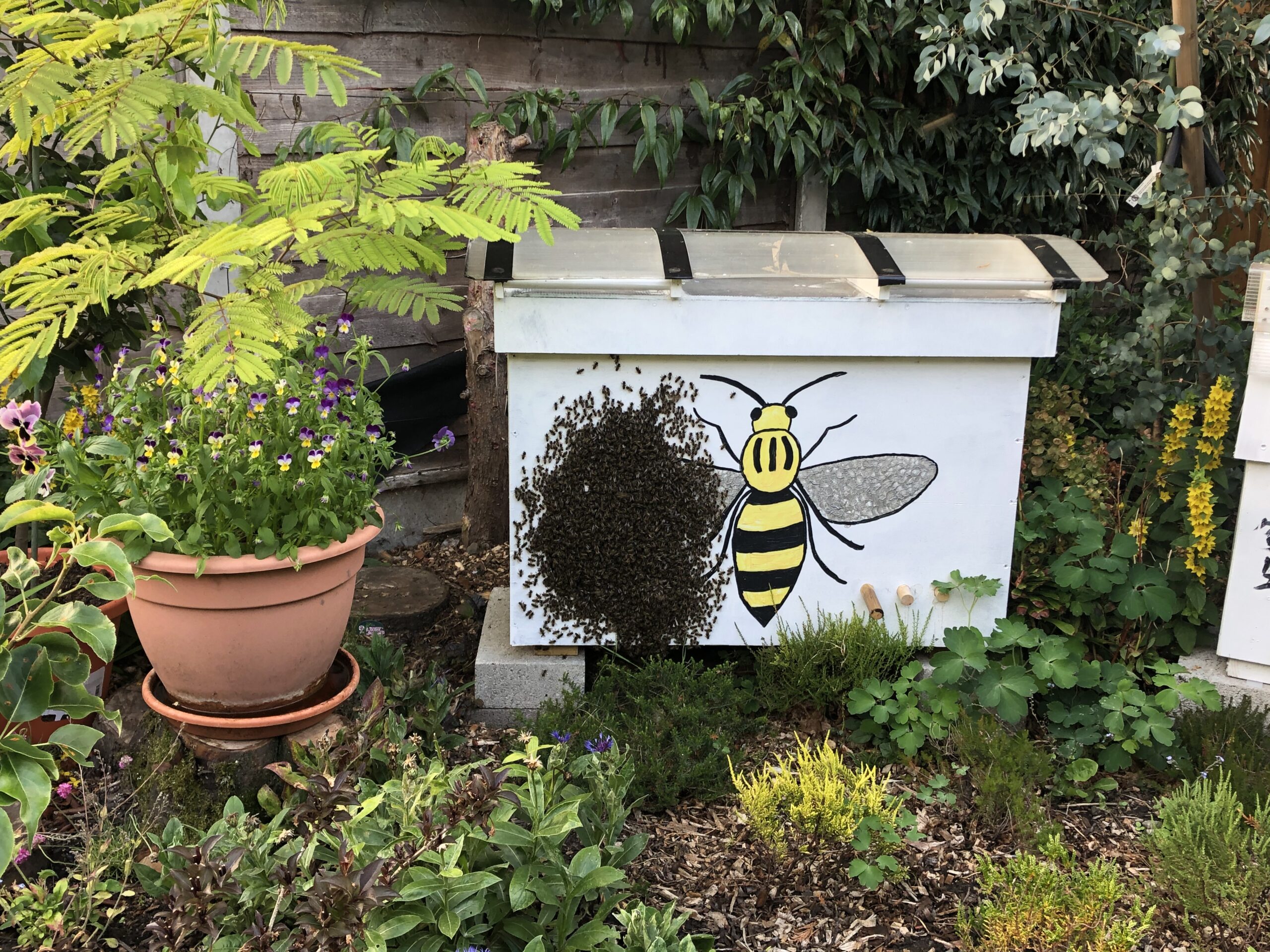
[…] M = Manchester hive […]